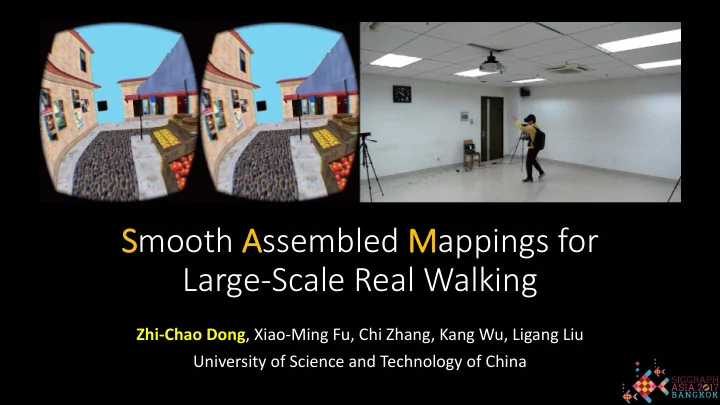

Smooth Assembled Mappings for Large-Scale Real Walking Zhi-Chao Dong , Xiao-Ming Fu, Chi Zhang, Kang Wu, Ligang Liu University of Science and Technology of China
Immersive virtual reality • A perception of being physically present in a non-physical world • VR systems provide an engrossing total environment HTC Vive Oculus Rift Sony Play Station
Locomotion in immersive VR • Joystick • Walking-in-place • Real walking stationary, unnatural
Locomotion in immersive VR • Joystick • Walking-in-place • Real walking simulated walking, less natural
Locomotion in immersive VR • Joystick • Walking-in-place • Real walking walk freely, natural
Goal: mapping for real walking • Build a mapping between the virtual scene and the real workspace • Optimal: bijective and isometric mapping Real workspace Virtual scene
Challenge • Virtual scene and real workspace often differ significantly in sizes , shapes . • How to explore large virtual scene in smaller real workspace? Virtual scene Real workspace
Existing methods in real walking • Space manipulation • [Suma et al. 2011, 2012], [Vasylevska and Kaufmann 2017], [Vasylevska et al. 2013] [Vasylevska et al. 2013]
Existing methods in real walking • Redirected walking • [Razzaque et al. 2001, 2002], [Williams et al. 2007], [Steinicke et al. 2010],[Hodgson and Bachmann 2013], [Azmandian et al. 2014], [Nescher et al. 2014] ··· [Steinicke et al. 2010] [Nescher et al. 2014]
Existing methods in real walking • Space mapping method • [Sun et al. 2016] : computing a global mapping between virtual and real scenes [Sun et al. 2016]
Problem: severe distortion • Mapping the large-scale virtual scene globally may result in severe distortions and artifacts. extremely large distortion The greater size ratio, the larger distortions
Our idea • S mooth A ssembled M appings ( SAM ): • A divide-and-conquer strategy • Benefits: map substantially large virtual scenes into smaller real workspaces with low isometric distortion achieve better walking experience
Our Method 1. Decomposition • Decompose the virtual scene into small super-patches 2. Mapping assembly • Each super-patch is mapped into real workspace 3. Global refinement • Reduce the distortion globally • Key challenges: • How to achieve low distortion mappings for large-scale virtual scene? • How to keep smoothness between local mappings?
Decomposition Input Partition patches
Decomposition Input Super-patches
Mapping assembly • Compute mappings for all super-patches one by one in a width-first order. The first super-patch Mapping result
Mapping assembly • Compute mappings for all super-patches one by one in a width-first order. The second super-patch Mapping and assembly
Mapping assembly • Compute mappings for all super-patches one by one in a width-first order. The other super-patches Mapping and assembly
Mapping a local quad patch • Bézier patch as a map: 𝑜 𝑛 𝑜 𝑣 𝐶 𝑛 (𝑤) 𝑔 𝑣, 𝑤 = 𝑑 𝑗,𝑘 𝐶 𝑗 𝑘 𝑗=0 𝑘=0 𝑑 𝑗,𝑘 : control points 𝑜 𝑣 : Bernstein polynomial basis function 𝐶 𝑗 𝑔 𝑄 𝑙 𝑇 𝑆 One patch Real workspace
Distortion cost: conforming low-distortion mapping • Distance-preserving cost: 2 2 + 𝜏 −2 𝐹 𝑗𝑡𝑝 (𝑞) = 𝜏 𝑘 𝑘 𝑘=1 𝜏 𝑘 : singular value of 𝐾(𝑞) When 𝜏 1 = 𝜏 2 = 1 , the mapping is isometric, i.e., distance-preserving 𝜏 2 𝜏 1 1
Boundary cost: avoiding colliding • Exterior boundary cost 4 2 𝑒 𝑘 > 0 𝐹 𝑓𝑦𝑢 𝑞 = 2 + 𝜗 𝑒 𝑘 + 𝑒 𝑘 interior 𝑞 𝑘=1 • Interior obstacle cost [Sun et al. 2016] 𝑣 ′ 2 𝑥 2 + 𝑤 ′ 2 𝐹 𝑗𝑜𝑢 𝑞 = exp − 1 2𝜏 2 ℎ 2 cos 𝜄 𝑑 − 𝑣 𝑑 𝑣 ′ = 𝑣 cos 𝜄 𝑑 sin 𝜄 𝑑 𝑤 𝑑 𝑤 ′ 𝑤 − sin 𝜄 𝑑
Constraints 𝑜 − 2 𝑜 − 1 1 2 • Smoothness constraints: 𝑙 𝑚 𝒅 𝑜,𝑘 = 𝒅 0,𝑘 𝑙 𝑙 𝑚 𝑚 𝑄 𝑙 𝑄 𝑚 𝒅 𝑜,𝑘 − 𝒅 𝑜−1,𝑘 = 𝒅 1,𝑘 − 𝒅 0,𝑘 𝑙 𝑙 𝑙 𝑚 𝑚 𝑚 𝒅 𝑜,𝑘 − 2𝒅 𝑜−1,𝑘 + 𝒅 𝑜−2,𝑘 = 𝒅 2,𝑘 − 2𝒅 1,𝑘 + 𝒅 0,𝑘 • Local bijection constraints: det 𝐾(𝑞) > 0 𝐾(𝑞) is the Jacobian of the mapping at 𝑞
Formulation and optimization min distoriton cost + boundary cost s. t. smoothness constraint local bijection constraint Optimization process • Super-patch based assembly • Newton’s method
Global optimization • Perform a global optimization after all assemblies
Recap: our SAM method
Experiments
Setup 3.6𝑛 × 3.6𝑛 sketch map real workspace
User studies: various virtual scenes
Interior obstacles
Comparison to [Sun et al. 2016]: simulation
Comparison to [Sun et al. 2016]: user study
Comparisons with redirected walking
Comparisons with redirected walking
Comparisons with redirected walking Square: user Circle: wolf
Comparisons with redirected walking Red: user Green: wolf
Applications
Conclusion • A novel divide-and-conquer method for mapping large-scale virtual scene into small real workspace • Much less distortion • Better walking experience • Can work for any large virtual scenes
Conclusion Limitations • Pathways with large widths • Only pathway-type scene Future work • Open scenes • Mapping scenes in AR
Acknowledgements • All participants of user studies • Qi Sun ([Sun et al. 2016]), Stony Brook University • Mahdi Azmandian ([Azmandian et al. 2016]), University of Southern California • Peng Song, Xuejin Chen, University of Science and Technology of China
Recommend
More recommend